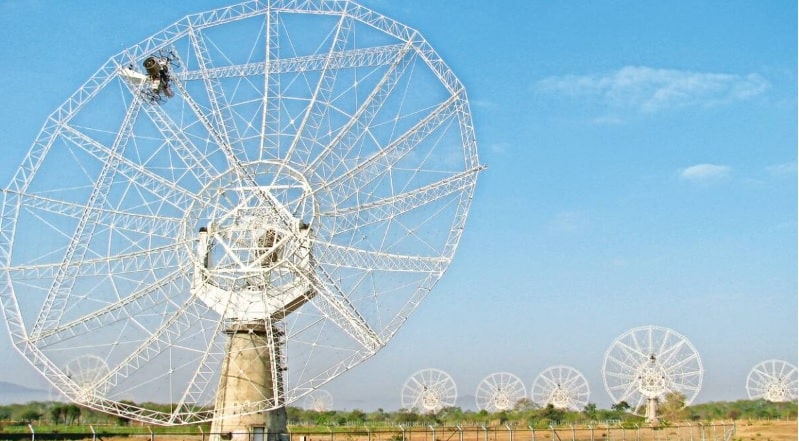What’s in today’s article?
- Why in news?
- What is Giant Metrewave Radio Telescope (GMRT)?
- What are the objectives of GMRT?
- What is the significance of GMRT?
- News Summary: Giant Metrewave Radio Telescope
Why in news?
- Scientists have expressed apprehension that the proposed Rs 16,000-crore Pune-Nashik high-speed rail project could jeopardise the operations of the Giant Metrewave Radio Telescope (GMRT) near Pune.
What is Giant Metrewave Radio Telescope (GMRT)?
- GMRT is a low-frequency radio telescope that helps investigate various radio astrophysical problems ranging from nearby solar systems to the edge of the observable universe.
- Located at Khodad, 80 km north of Pune, the telescope is operated by the National Centre of Radio Astrophysics (NCRA).
- NCRA is a part of the Tata Institute of Fundamental Research (TIFR), Mumbai.
- GMRT is a project of the Department of Atomic Energy (DAE), operating under the Tata Institute of Fundamental Research (TIFR).
- It consists of 30 fully- steerable dish type antennas of 45-meter diameter each, spread over a 25-km region.
- GMRT is presently the world’s largest radio telescope operating at meter wavelength.
What are the objectives of GMRT?
- Although GMRT will be a very versatile instrument for investigating a variety of radio astrophysical problems, two of its most important astrophysical objectives are:
- to detect the highly redshifted spectral line of neutral Hydrogen expected from protoclusters or protogalaxies before they condensed to form galaxies in the early phase of the Universe and
- Redshift represents the signal’s wavelength change depending on the object’s location and movement.
- to search for and study rapidly-rotating Pulsars in our galaxy.
- Pulsars are rapidly rotating neutron stars with extremely high densities.
- to detect the highly redshifted spectral line of neutral Hydrogen expected from protoclusters or protogalaxies before they condensed to form galaxies in the early phase of the Universe and
What is the significance of GMRT?
- Highly sought-after telescope
- GMRT is a unique facility functioning within the frequency bandwidth of 100 Mhz-1,500 MHz.
- It is a highly sought-after telescope both within India and by scientists from 30-plus countries.
- Understanding the evolution of galaxies over cosmic time
- Understanding the evolution of galaxies over cosmic time requires tracing the evolution of neutral gas at different cosmological periods.
- Atomic hydrogen is the basic fuel required for star formation in a galaxy.
- When hot ionised gas from the surrounding medium of a galaxy falls onto the universe, the gas cools and forms atomic hydrogen.
- This then becomes molecular hydrogen and eventually leads to the formation of stars.
- Atomic hydrogen emits radio waves of 21 cm wavelength, meaning the wavelength is a direct tracer of the atomic gas content in nearby and distant galaxies.
- However, this radio signal is feeble and nearly impossible to detect the emission from a distant galaxy.
- Using GMRT data, recently scientists detected signal that was emitted from a distant galaxy when the universe was only 4.9 billion years old.
- Understanding the evolution of galaxies over cosmic time requires tracing the evolution of neutral gas at different cosmological periods.
- Galactic and extragalactic radio sources
- Because of its large collecting area and wide frequency coverage, GMRT is an useful instrument for studying many other problems at the frontiers of astrophysics.
- These include studies of Solar and planetary radio emissions; relationship between Solar activity and disturbances in the interplanetary medium etc.
News Summary: Giant Metrewave Radio Telescope
- The Ministry of Railways gave ‘in-principle’ approval to the Pune-Nashik high-speed rail project.
- The high-speed railway line will cover a distance of 235 km in under two hours.
- As per the proposal, trains will run at a speed of 200 km/hr.
- It is being feared that this project could jeopardise the operations of the Giant Metrewave Radio Telescope (GMRT).
- Radio noise and interference from this rail project might affect the working of GMRT.
- A majority of the dish antennas of GMRT come within unacceptably close range of the railway line.
Q1) In which Indian state is the Giant Metrewave radio Telescope located?
The Giant Metrewave Radio Telescope (GMRT) is located at Khodad, 80 km away from Pune, in the state of Maharashtra.
Q2) What are pulsars?
Pulsars are rapidly rotating neutron stars that blast out pulses of radiation at regular intervals ranging from seconds to milliseconds.
Source: Rail tracks too close, scientists air concern for world’s largest radio telescope | Giant Metrewave Radio Telescope | Down To Earth
Last updated on December, 2025
→ Check out the latest UPSC Syllabus 2026 here.
→ Join Vajiram & Ravi’s Interview Guidance Programme for expert help to crack your final UPSC stage.
→ UPSC Mains Result 2025 is now out.
→ UPSC Notification 2026 is scheduled to be released on January 14, 2026.
→ UPSC Calendar 2026 is released on 15th May, 2025.
→ The UPSC Vacancy 2025 were released 1129, out of which 979 were for UPSC CSE and remaining 150 are for UPSC IFoS.
→ UPSC Prelims 2026 will be conducted on 24th May, 2026 & UPSC Mains 2026 will be conducted on 21st August 2026.
→ The UPSC Selection Process is of 3 stages-Prelims, Mains and Interview.
→ UPSC Result 2024 is released with latest UPSC Marksheet 2024. Check Now!
→ UPSC Prelims Result 2025 is out now for the CSE held on 25 May 2025.
→ UPSC Toppers List 2024 is released now. Shakti Dubey is UPSC AIR 1 2024 Topper.
→ UPSC Prelims Question Paper 2025 and Unofficial Prelims Answer Key 2025 are available now.
→ UPSC Mains Question Paper 2025 is out for Essay, GS 1, 2, 3 & GS 4.
→ UPSC Mains Indian Language Question Paper 2025 is now out.
→ UPSC Mains Optional Question Paper 2025 is now out.
→ Also check Best IAS Coaching in Delhi

















